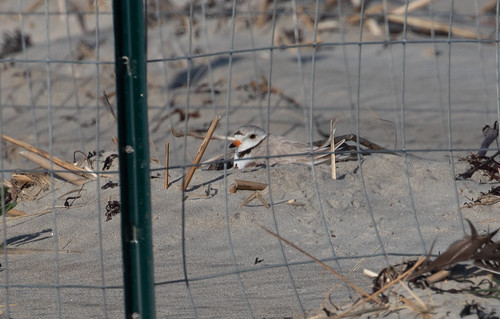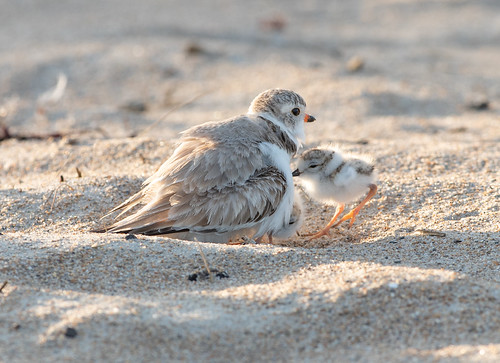Coping with this pandemic has been way easier on birds than on humans. In the case of one of my favorite birds of all, the Piping Plover, which spends every part of its annual cycle on sand beaches, this pandemic has been a bona fide blessing. Thanks to many beaches closing down in early spring, plovers had a very easy time pigging out in anticipation of spring migration, and then resting whenever they needed to stop for some R&R en route, allowing them to be in prime condition as they reached the beaches where they breed.
Chicago’s Monty and Rose, the Piping Plovers that famously and successfully nested at Montrose Beach last summer—the first pair of Piping Plovers to nest within the city since 1955—were first seen on the beach this April 30, and by May 23 had produced a full clutch of eggs.
Not being affected by beachgoers and their dogs, the birds selected a spot a on slightly higher ground than last year, so almost certainly will not require any intervention by humans to move them out of harm’s way before a storm as people had to do last year.
When the nest was discovered, people set what’s called an “exclosure” around the nest. It looks like a big cage, with the bars far enough for plovers to easily walk in and out while raccoons, gulls, and other predators, along with humans and their dogs, can’t get close to the eggs. The longer the beach stays closed, the better for the birds, but volunteers from Chicago Audubon and other groups did an excellent job of keeping the public informed about the birds last year. Most human beings with functioning hearts are willing to curtail some of their fun in order to protect such adorable, vulnerable chicks.
Monty and Rose belong to the endangered Great Lakes population of Piping Plovers, which was once down to fewer than 20 pairs. Now that number is up to 70. At Michigan’s Sleeping Bear Dunes National Lakeshore and other Lake Michigan beaches, birds are back earlier than last year, and starting to nest, too. The more successful each pair is each year, and the more aware the general public is about just how wonderful this little bird is, the healthier the species’ long-term prospects even as the rising water levels associated with climate change continue apace.
Last year I spent quite a bit of time waching and photographing Piping Plovers in the Atlantic population. I saw adults in in Maine. I watched nesting Piping Plovers at Popham Beach State Park before the birding festivals I was involved with...
...and after my festivals were over, my friend Laurie Gilman brought me to a few beaches after the eggs had hatched, so I finally was able, for the first time in my life, to photograph baby plovers.
Maine had a record year of nesting plovers last year, with 89 pairs successfully fledging 175 chicks. Apparently, some of those new birds are starting to breed this year; there are 100 pairs and 61 active nests in the state. I’m SO hoping that some of the new breeding adults are ones I photographed as chicks last year.
Having beaches closed for an important chunk of the breeding season will definitely boost nesting success, but eventually people, including those with dogs, will be thronging to them again. I’m hoping that this virus will give us a new appreciation of how tenuous life is, and how vulnerable living things are, but also how valuable our fellow creatures are, in ways not measured in dollars. Our slowing down for so many weeks has made air cleaner in big cities, and has allowed natural wild creatures to thrive for once. Perhaps this awful pandemic will lead to our species—the only one on the planet that includes actual rocket scientists—to finally figure out how we can enjoy natural resources without damaging them. If so, this banner year of adorable Piping Plovers will lead to better and better such years in the future.









